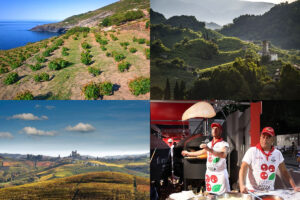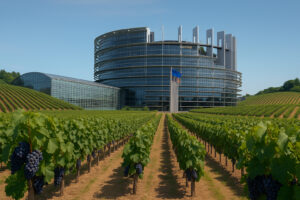A journey through art, science and mythology, which traces the 6,000 year old history of wine in ancient Mediterranean civilizations: “Vinum Nostrum” the exhibition at the Museo degli Argenti in Palazzo Pitti in Florence (until April 30, 2011), which highlights not only the archaeological and anthropological aspects of the relationship between man and wine, but how Bacchus’ nectar has been a major catalyst of artistic language. Important findings – pitchers from the sixth millennium BC, inscriptions on stone and clay, Roman and Pompeian frescoes, statues, bas-reliefs, painted vases, glasses and containers in precious metals, but also evidence of Greek and Latin poets and writers - take visitors on a fascinating journey into the ancient world of the Near East and the Mediterranean civilizations. Giovanni Di Pasquale, Annamaria Ciarallo and Ernesto De Carolis edited the catalog (published by Giunti). The exhibition - created by Paolo Galluzzi, curated by Giovanni di Pasquale and other scholars (including Professor Attilio Scienza, Professor of viticulture at the University of Milan) - reveals that especially the Greeks adored wine: besides producing prestigious varieties, they also introduced the custom of the symposia, or sumptuous banquets accompanied by large quantities of wine. The Greeks also created Dionysus, the patron God of wine and vine, who would wander pleasurably inebriated in the woods, followed by nymphs and satyrs. Dionysus was transformed into Bacchus and was adopted by all artists, ancient and modern.
Focus - the Mediterranean, a sea of wine
- Temetum: this was the name the Romans gave to the strong, pure, heady wine, forbidden to women. A “poison” that only males could drink and the men were given permission to kill their wives, the matrons, if they surprised them drinking a glass of wine. This was the life-style in ancient Rome, when wine already had a long and complex history that coincided with and touched all aspects of humanity.
- The first people to drink a glass of wine were farmers in Anatolia, who planted the vines on Mount Ararat, where according to the Bible, Noah had planted a vineyard. The farmers kept the wine in clay jars, like the pitcher from the sixth millennium BC, the most ancient find now displayed in the Georgian National Museum in Tbilisi. Wine trading started from the fourth millennium B.C. in Asia and is documented by letters written on clay tablets and exchanged between various kings.
- The power of wine, a healthy but dangerous beverage, has fascinated all Mediterranean populations beginning with the Egyptians and Greeks. Egyptian funerary stelae depict offering the deceased, together with bread, meat and onions, large amphoras containing wine.
- Many, like the scribe Senenra, immortalized on the walls of their own tombs the process of siphoning wine from the amphoras. The Greeks were crazy for the sacred nectar and produced not only fine wines, marketing them throughout the Mediterranean, but also introduced the custom of symposia, banquets for aristocrats based on great amounts of wine, used to get to the truth, as Plato had asserted. Moreover, they created the legendary and contradictory Dionysus, God of wine, protector of lives, wandering in the woods happily inebriated with an entourage of nymphs and satyrs. Dionysus was transformed into Bacchus and adopted by all artists, ancient and modern. The Greeks of the IV-III century BC depicted Dionysus on cups in black with an intriguing profile, together with his mother Semele, among wine, vines and grapes, or in the throes of orgasms, hallucinations, euphoria, madness. He was depicted in carved bas-reliefs and whether young or old, he was always drinking wine.
- The myth of Dionysus and his wild satyrs passes on from Magna Greece to cities in the Campania region like Pompeii and Herculaneum: where craft workshops blossomed and turned out superbly crafted iconography associated with Dionysian scenes and where grapevines were expertly cultivated (Greek Vitis, OleaginaVitis, Columbina purpurea) and special wines produced. This territory, devastated by the eruption in 79 AD, still today reveals many important traces of vine cultivation, production, storage and marketing of wine. What about Rome? Rome idolized wine, its taste, smell and aging process. It was the main attraction in banquets and orgies. However, from Romulus on only men could drink it: it was forbidden to women, who had to settle for lighter drinks. Why? Because, as Dionysus of Halicarnassus explained, wine could turn women away from their matronly virtues and easily turn them into drunkards and adulteresses. Just like that beautiful marble Old Woman, drunk, from the second century BC, by Myron of Thebes. Egnazio Mecennio, for example, beat his wife to death with a stick because he had found her drinking wine and everyone approved of his actions, as reported by the historians Valerius Maximus and Pliny the Elder.
- Husbands feared the lust of their wives so much so that the “jus osculum”, the right to kiss, was practiced: the relatives of future wives kissed them on the mouth to see if they smelt of wine. If they did the marriage was called off and the woman was put to death, possibly by starvation. Of course there were ways to get around this: Agrippa, for example, reported Suetonius, seduced her uncle Claudius, brother of her father Germanicus, who fell in love with her with a kiss on the mouth - the kiss trap. The end of the Republic, however, marked a new age for women: makeup, divorce, spas and wine, including getting drunk.
Source: www.mauriziatazartes.it
Maurizia Tazartes, history and art critic is a researcher and the author of books, papers and specialized articles. Since 1979, she has written on the cultural pages of major newspapers. She has been a Member of the National Order of Journalists of Rome since 1982 and the AIC (Association Internationale des Critiques d’Art) since 1998. Among her most recent books Vermeer (Knopf, 2008) and Il “ghiribizzoso” Pontormo (Mauro Pagliai Editor, 2008).
Info: info@mauriziatazartes.it
Copyright © 2000/2025
Contatti: info@winenews.it
Seguici anche su Twitter: @WineNewsIt
Seguici anche su Facebook: @winenewsit
Questo articolo è tratto dall'archivio di WineNews - Tutti i diritti riservati - Copyright © 2000/2025








































































































































































































